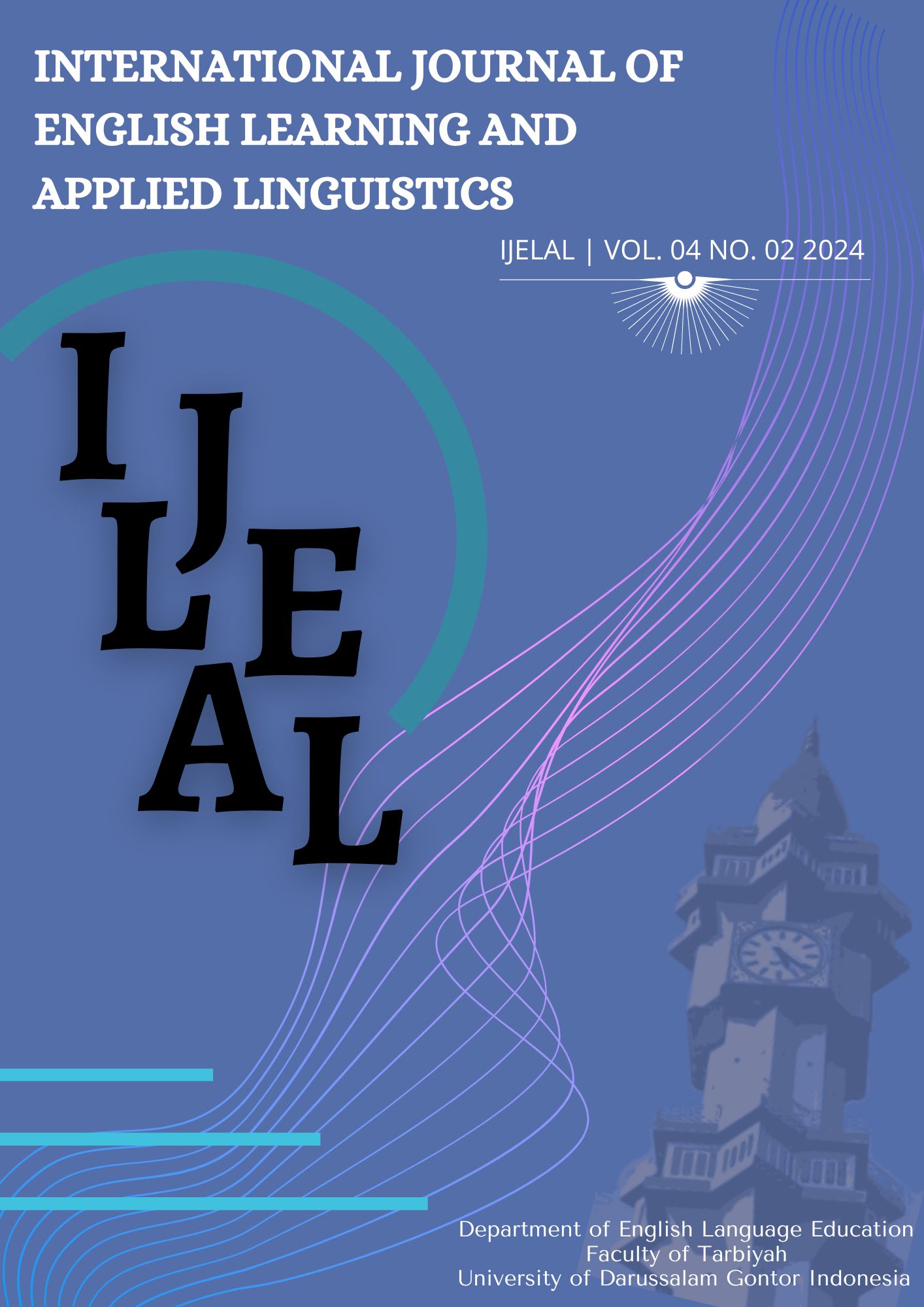ANALYZING THE STRUCTURE AND EFFECTIVENESS OF LESSON PLANS FOR PRE-SERVICE ENGLISH LANGUAGE TEACHERS
DOI:
https://doi.org/10.21111/ijelal.v4i2.11633Keywords:
Analysis, Effectiveness, English Language, Lesson Plan, Pre-service Teachers, StructureAbstract
References
Ab Aziz, A., Swanto, S., & Azhar, S. (2019). Coping with stress: Exploring the lived experiences of English teachers who persist in Malaysian rural schools. Indonesian Journal of Applied Linguistics, 8(3), 506-514. Available at: https://ejournal.upi.edu/index.php/IJAL/article/viewFile/15249/8791.
Akther, A. (2014). Role of Warm-up Activity in Language Classroom: A Tertiary Scenario. BRAC University: Bangladesh. https://core.ac.uk/display/61804799?utm_source=pdf&utm.
Akyüz, A. et al. (2018). Integrating Culture in Language Classrooms: The Effects in Teaching and Learning. In: Innovative Practices in Teacher Preparation and Graduate-Level Teacher Education Programs (1st ed.). ICI Global. Available at: http://www.igi-global.com/chapter/integrating-culture-in-language.
Amalia, L. et al. (2020). Reflective practice on lesson planning among EFL teacher educators. Indonesian Journal of Applied Linguistics, 10(1), 153-160. Available at:https://ejournal.upi.edu/index.php/IJAL/article/view/25025.
Black, P., & William, D. (1998). Assessment and Classroom Learning. Assessment in Education, 5(1), 7-74. Available at:http://dx.doi.org/10.1080/0969595980050102.
Bonwell, C., & Eison, J. (1991). Active Learning; Creating Excitement in the Classroom. ASHE-ERIC Higher Education Report. Washington, D.C.: The George Washington University, School of Education and Human Development. Available at: https://api.semanticscholar.org/CorpusID:141471164.
Brittin, R.V. (2005). Preservice and Experienced Teachers’ Lesson Plans for Beginning Instrumentalists. Journal of Research in Music Education 53(1), 26-39. Available at: https://api.semanticscholar.org/CorpusID:145433691.
Brown, H., & Abeywickrama, P. (2010). Language assessment: Principles and classroom practices (2nd ed.). Thousand Oaks, CA: Pearson. Available at: https://www.bing.com/ck/a?!&&p=2acb887e9517dadfJ.
Clark, C. & Dunn, S. (1991). Second Generation Research on Teacher Planning. In H. C. Warren & H. J. Walberg, Effective Teaching: Current Research. Berkeley, CA: McCatchum, 183-200.
Clark, C. M., & Peterson, P. L. (1986). Teachers' thought processes. MC Wittrock (Ed.) Handbook on research in teaching. Available at: https://education.msu.edu/irt/PDFs/OccasionalPapers/op072.pdf.
Cozgu, E. & Caganaga, C. (2016). The importance of using games in EFL classrooms. Cypriot Journal of Educational Sciences, 11(3), 126-135. Available at: http://sproc.org/ojs/index.php/cjes/.
Diril, A. (2015). The Importance of Icebreakers and Warm-Up Activities in Language Teaching. ACC Journal, 21(3),143-144. DOI:10.15240/tul/004/2015-3.
Dorovolomo, J., Phan, H., & Maebuta, J. (2010). Quality Lesson Planning and Quality Delivery: Do they Relate? The International Journal of Learning, 17(3), 448- 455. http://www.Learning-Journal.com.
Dunn, R. et al. (2010). No Light at the End of Tunnel Vision: Steps for Improving Lesson Plans”. The Clearing House: A Journal of Educational Strategies, Issues and Ideas 83(5), 194-206. Available at: https://api.semanticscholar.org/CorpusID:143523164.
Echevarria, J., Vogt, M., & Short, D. (2018). Making Content Comprehensible for Secondary English Learners: The SIOP Model (3rd ed.). Pearson. Available at: https://www.bing.com/ck/a?!&&p=bc157ba5797c715bJmltdHM9.
Emiliasari, R., & Jubaedah, I. (2019). Lesson Planning in EFL Classroom: A Case Study in Lesson Plan Preparation and Implementation. Wiralodra English Journal, 3(2), 367-375. Available at: https://api.semanticscholar.org/CorpusID:210452860.
Fathil, F., Ziden, A., & Osman, S. (2021). Lesson Planning Practices and Lesson Planning System Design Preferences Among Novice ESL Teachers. Journal of Educational Research and Indigenous Studies, 3(1), 170-184. Available at: http://www.jerisjournal.com/.
Gallego, M. (2007). Lesson Planning in Primary and Secondary Education. Available at: https://www.researchgate.net/publication/269463679_Lesson.
Hammond, L. (2006). Constructing 21st- Century Teacher Education. Journal of Teacher Education, 57(1), 300–314. Available at: https://api.semanticscholar.org/CorpusID:143245446.
Harmer, J. (2012). Essential teacher knowledge. Harlow: Pearson Education Limited. Available at: https://www.bing.com/ck/a?!&&p=006d3f1e4eaffa6cJmltdHM9MT.
Jasmi. (2014). English Teachers’ Difficulties in Designing Lesson Plan Based on 2013 Curriculum. The 61st TEFLIN International Conference.
John, P. (2006). Lesson planning and the student teacher: re-thinking the dominant model. Journal of Curriculum Studies, 38(4), 483–498. Available at: http://www.tandf.co.uk/journals.
Johnson, A. P. (2000). It's Time for Madeline Hunter to Go: A New Look at Lesson Plan Design. Action in Teacher Education, 22(1), 72-78. Available at: https://www.bing.com/ck/a?!&&p=9a3e4457bd98fd97JmltdHM9MT.
Jones, K., Jones, J., & Vermette, P. (2011). Six common lesson planning pitfalls: Recommendations for novice educators. Education, 131(4), 845–864. Available at: http://eds.a.ebscohost.com/eds/pdfviewer/pdfviewer?vid=2&sid=f449f.
Kagan, D., & Tippins, D. (1992). The Evolution of Functional Lesson Plans Among Twelve Elementary and Secondary Student Teachers. The Elementary School Journal 94, 477-489. Available at: https://api.semanticscholar.org/CorpusID:145719980.
Katz, A. (2014). Assessment in second language classrooms. In: M. Celce-Murcia, D. M. Brinton & M. A. Snow (Eds.), Teaching English as a second or foreign language (4th ed.) (pp. 320-229). Boston, MA: National Geographic Learning. Available at: https://www.bing.com/ck/a?!&&p=105831c83cfdaa4cJmltdHM9M.
Ko, E. K. (2012). What is your objective? Preservice teachers' views and practice of instructional planning. The International Journal of Learning, 18(7), 89-100. Available at: https://www.bing.com/ck/a?!&&p=b04fd711c3a507b6JmltdHM9M.
Lederman, N., & Niess, M. (2000). If you fail to plan, are you planning to fail? School Science and Mathematics, 100(2), 57-61. Available at: https://doi.org/10.1111/j.1949-8594.2000.tb17246.x.
Lewis, C. et al. (2019). How Does Lesson Study Work? Toward a Theory of Lesson Study Process and Impact. Advances in Mathematics Education, 13-37. https://doi.org/10.1007/978-3-030-04031-4_2.
Li, Y., Chen, X., & Khum, G. (2009). Mathematics Teachers’ Practices and Thinking in Lesson Plan Development: A Case of Teaching Fraction Division. ZDM Mathematics Education 41, 717–731. Available at: https://api.semanticscholar.org/CorpusID:14385.
MacDonald, J., & Phillips, R. (2005). Developing teaching briefs and plan teaching sessions. Education for Primary Care, 16, 496-498.
Maniruzzaman, M., & Rahman, M. (2008). The Use of Audio Aids in the EFL Class at the Tertiary Level: A Plus or a Minus? Daffodil University International Journal of Business and Economics, 3, 121-137. Available at: http://dspace.daffodilvarsity.edu.bd:8080/bi.
McCutcheon, G. (1980). How do elementary school teachers plan? The Nature of Planning and Influences on It. Elementary School Journal 81(1), 4-23. Available at: https://api.semanticscholar.org/CorpusID:143980658.
Milkova, (2016). Strategies for Effective Lesson Planning. Stiliana Milkova Center for Research on Learning and Teaching. Available at: https://www.bing.com/ck/a?!&&p=6358303b4f162b0bJmltdHM9.
Miller, L. (2009). Reflective Lesson Planning: Promoting Learner Autonomy in the Classroom. In R. Pemberton, S. Toogood, & A. Barfield (Eds.), Maintaining Control: Autonomy and Language Learning (pp. 109–124). Hong Kong: Hong Kong University Press.
Mills, G. E. (2011). Action Research: A Guide for the Teacher Researcher. Upper Saddle River, NJ: Pearson.
Mofareh, A. (2019). The Use of Technology in English Language Teaching. Frontiers in Education Technology, 2(3), 168 -180. Available at: www.scholink.org/ojs/index.php/fet.
Mutton, T., Hagger, H., & Burn, K. (2011). Learning to plan, planning to learn: The developing expertise of beginning teachers. Teachers and Teaching: Theory and Practice, 17(4), 399-416. https://doi.org/10.1080/13540602.2011.580516. .
Neisari, A., & Heidari, M. (2014). The Important Role of Lesson Plan on Educational Achievement of Iranian EFL Teachers’ Attitudes. International Journal of Foreign Language Teaching and Research, 2,25-31. Available at: https://api.semanticscholar.org/CorpusID:148099164.
Nunan, D. (2015). Teaching English to speakers of other languages: An introduction. New York, NY/Abingdon: Routledge. Available at: https://api.semanticscholar.org/CorpusID:60865035.
Ong, S., Mahamod, Z., & Mohd Hamzah, M. (2017). Exploring teaching methods of Sarawak Malay language excellent teacher: A case study. Malay Language Education Journal,7(1), 93-108. Available at: http://spaj.ukm.my/jpbm/index.php/jpbm/article/view/138/129.
Permana, M. A. (2010). Analysis on the Problems Faced by Teachers in Designing Lesson Plan Based on School-base d Curriculum (SBC) at SMAN 1 Sumenep. Unpublished Undergraduate Final Project. University Muhammadiyah: Malang.
Phillips, J., & Phillips, P. (2008). Beyond learning objectives: Develop measurable objectives that link to the bottom line. Birmingham, Ala: ROI Institute.
Putri, A. (2017). EFL Teachers’ Understanding in Developing Lesson Plan. Indonesian EFL Journal, 2(1), 1-11. Available at: https://api.semanticscholar.org/CorpusID:113952645.
Redfern, A. (2015). The essential guide to classroom practice: 200+ strategies for outstanding teaching and learning. Abingdon: Routledge. Available at: https://doi.org/10.4324/9781315755557.
Richards J. C. (1998). Beyond Training: Perspectives on Language Teacher Education. New York, Cambridge University Press. Available at: https://www.bing.com/ck/a?!&&p=e0a.
Rubiano, D., & Granada, L. (2020). Inspiring pre-service English teachers to set up their lesson plans: tailoring student´s engagement to ensure learning goals. Tendencias en la Investigación Universitaria, 1, 480-493. Available at: https://api.semanticscholar.org/CorpusID:226142647.
Savignon, S. J. (2001). Communicative language teaching for the twenty-first century. In M. Celce-Murcia (Ed.), Teaching English as a second or foreign language (3rd ed.) (pp. 13–28). Boston, MA: Heinle & Heinle.
Senior, R. (2006). The Experience of Language Teaching. New York, Cambridge University Press. Available at: https://api.semanticscholar.org/CorpusID:60178820.
Snow, D. (2006). More than a native speaker: An introduction to teaching English abroad. Alexandria, VA: TESOL. Available at: https://api.semanticscholar.org/CorpusID:60063689.
Syed Ali, S. K. (2018). Teachers' planning and preparation for lesson plan in the implementation of form 4 physical education curriculum for the physical fitness strand. Malaysian Online Journal of Educational Sciences, 1(4), 38-47. Available at: http://adum.um.edu.my/index.php/MOJES/article/download/12872/8265.
Tagle, T. et al. (2020). Lesson Planning: What Types of Professional Knowledge are Activated by Chilean Pre-Service EFL Teachers? Electronic Journal of Foreign Language Teaching, 17(1), 258–271. Available at: http://e-flt.nus.edu.sg/.
Taskin, C. (2017). Exploring Pre-service Teachers' Perceptions of Lesson Planning in Primary Education. Journal of Education and Practice, 8(12), 57-63. Available at: http://www.iiste.org/.
Touati, M. (2016). The Integration of Culture in Foreign Language Learning at an Advanced Level. Annales des Lettres et des Lanues, 2016(6),106-117. Available at: https://www.researchgate.net/publication/335544378.
Velandia, R. (2008). The Role of Warming Up Activities in Adolescent Students’ Involvement during the English Class. Profile Issues in Teachers' Professional Development, 10, 9-26. Available at: https://api.semanticscholar.org/CorpusID:143045159.
Wandberg, R., & Rohwer, J. (2003). Teaching to the Standards of Effective Practice: A Guide to Becoming a Successful Teacher. Pearson.
Widiati, U., Suryati, N., & Hayati, N. (2018). Unravelling the challenges of Indonesian novice teachers of English. Indonesian Journal of Applied Linguistics, 7(3), 621-629. Retrieved from https://ejournal.upi.edu/index.php/IJAL/article/viewFile/9824/6173.
Yaccob, N., & Yunus, M. (2019). Language Games in Teaching and Learning English Grammar: A Literature Review. Arab World English Journal, 10 (1), 209 -217. DOI: https://dx.doi.org/10.24093/awej/vol10no1.18.
Downloads
Published
Issue
Section
License

This work is licensed under a Creative Commons Attribution-NonCommercial-ShareAlike 4.0 International License.
Copyright notice:
- Authors retain copyright and grant the journal right of first publication with the work simultaneously licensed under a Creative Commons Attribution License that allows others to share the work with an acknowledgement of the work's authorship and initial publication in this journal.
- Authors are able to enter into separate, additional contractual arrangements for the non-exclusive distribution of the journal's published version of the work (e.g., post it to an institutional repository or publish it in a book), with an acknowledgement of its initial publication in this journal.
- Authors are permitted and encouraged to post their work online (e.g., in institutional repositories or on their website) prior to and during the submission process, as it can lead to productive exchanges, as well as earlier and greater citation of published work (See The Effect of Open Access)






